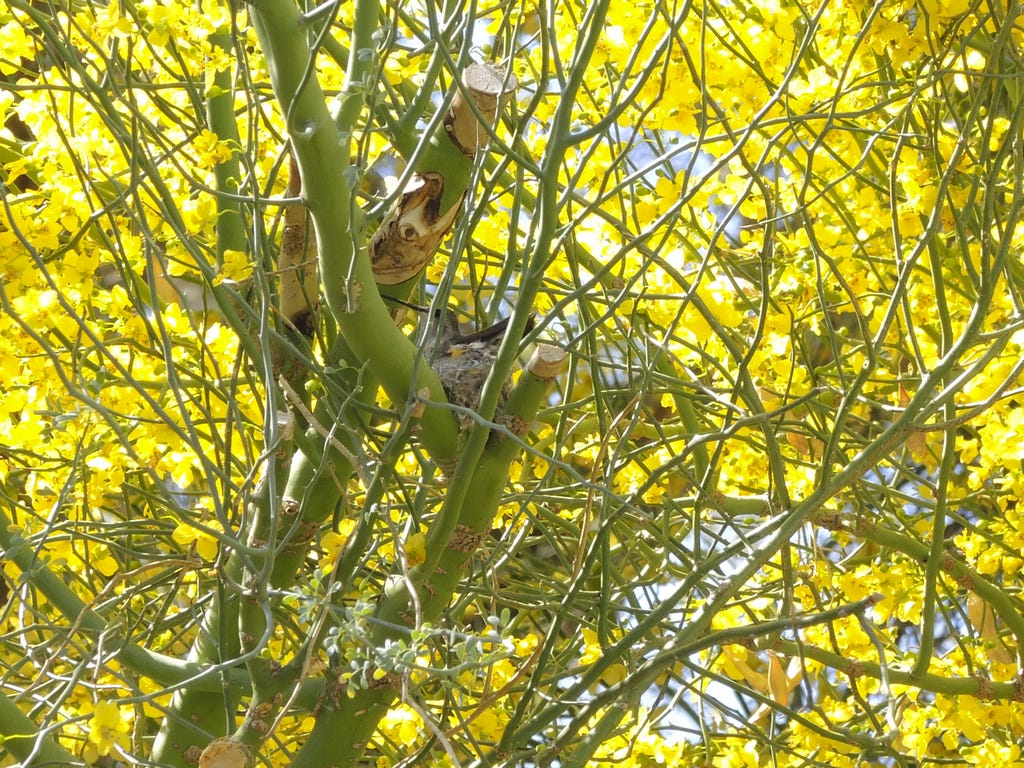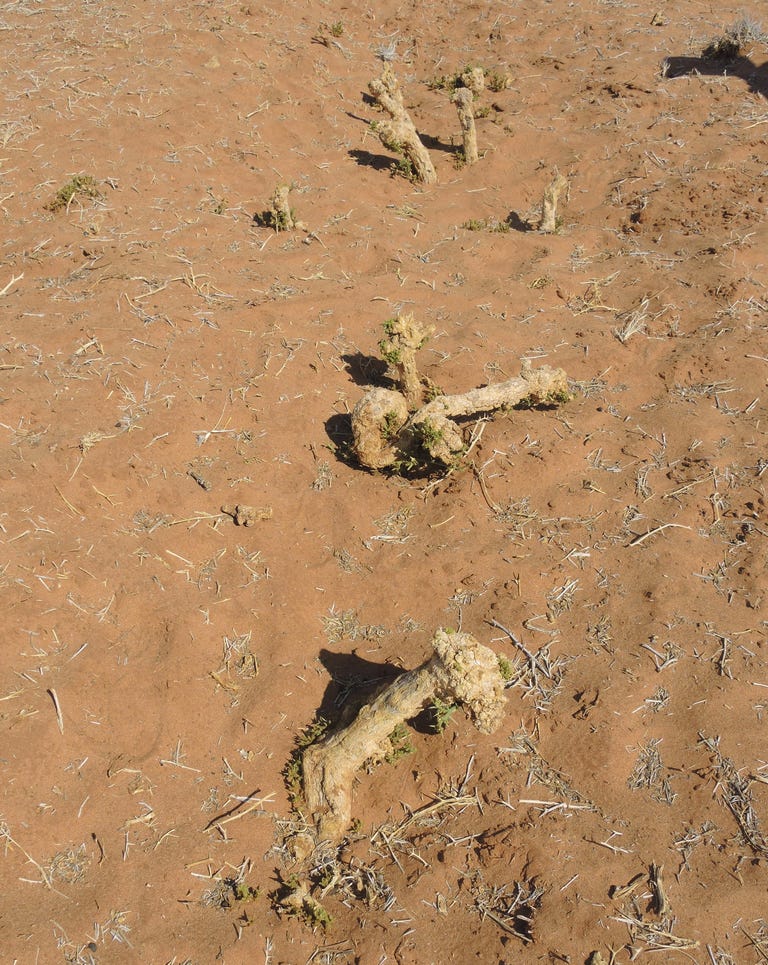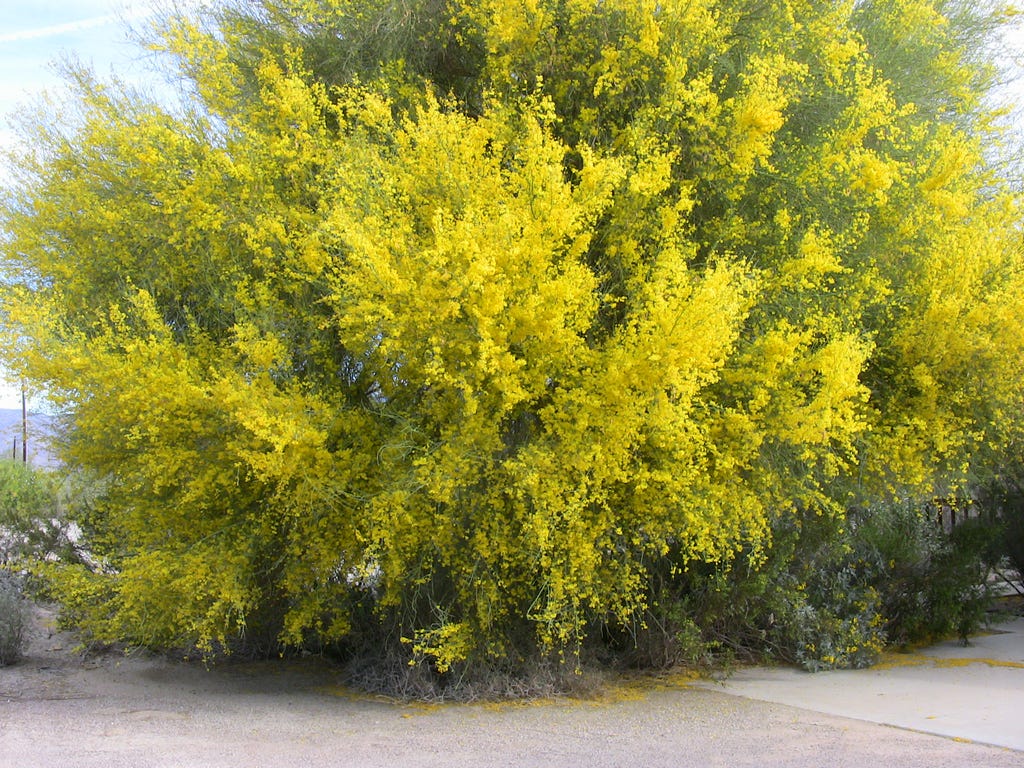
We who live in the well-watered parts of the world take the green, leafy nature of the plant world around us as a given, for we understand what leaves do for plants (and indirectly for us) --- they capture photon-energy from sunlight and use it to convert carbon dioxide into plant material in the process of photosynthesis. This is the first step in how energy enters the living world, to flow through from creature to creature through herbivory, parasitism, predation, and decomposition, each of which returns increments of the carbon to the atmosphere, with the final remnants of what is left returned by microbial decomposers. These are the familiar lessons of middle school that place the sun at the center of the living world. Leaves are the wonderful devices that make it all possible.
But in the deserts of the world, leaves are a liability, for to do their work, leaves must evaporate water into the atmosphere through holes in their undersides called stomata, and in deserts, water is obviously precious. As a result, desert plants have had to evolve workarounds to solve this problem of losing precious water to photosynthesize. Some have leaves only after abundant rains, then shed them and remain dormant until the next rain, a sort of plant cop-out. Others evolved leaves with thick cuticle and curled margins or lots of fuzz on the underside, all of which reduce, but do not eliminate water loss. At the extreme, they have simply done away with leaves altogether, and have moved chlorophyll and photosynthesis to green stems and branches, places that have no stomata to evaporate water to the atmosphere.
As a result, there are many leafless or mostly leafless plants in the deserts of the world. In North America, the leaflessness of cacti goes without saying, for all species in the family are leafless. More informative examples of the loss of leaves come from families in which most species have abundant leaves, so that going from a leafy ancestry to leafless takes a lot more doing. A species in the pea family, the palo verde (Spanish: green stick) tree in the Sonoran and Colorado deserts is a good example of a tree that mostly does without leaves. I say mostly, because palo verde cannot escape its evolutionary origin, and young twigs carry a sprinkling of dinky little compound leaves, with leaflets the size of afterthoughts. Perhaps these mini-leaves help produce the twig that bears them, but once that job is done, the green in the palo verde is to be found ever after in the (now bare) twigs, branches and trunks of these trees.
After winter rains the blue palo verde’s profuse yellow flowers color trees solid yellow, but the material for these flowers was built mostly from photosynthesis taking place in twigs and branches.

Another tree in the same deserts, the smoke tree (see image at the top), has also done its best to do without leaves, but it too has not entirely escaped its evolutionary legacy. From its presumably leafy ancestry, the smoke tree has become a mass of stiff, prickly green/grey branches and twigs that do not invite interlopers. It too has moved photosynthesis into its twigs and branches. Before it blooms, it grows an anemic crop of glandular leaves that are shed before the great flowering induced by summer rains, cloaking smoke trees in deep purple flowers that color the washes in which the trees grow. Also a member of the pea family, its seeds are produced in pods, and need to be rolled and abraded in a flash flood to stimulate germination. This dependence on floods assures that the germinating seedlings will be well-watered as they germinate, but if the seeds are rolled too far, they are ground to oblivion. Thus, smoke trees tend to be spaced out in dry washes.

Sometimes a plant with mostly very leafy relatives succeeds in entirely shedding its evolutionary legacy to become truly, permanently and entirely leafless. The nara melon of the Namib Desert, a species in the cucumber family is such a plant. In place of the beautiful, lobed leaves of most of the "normal" species in the cucumber family (see below), the nara grows into a leafless, tangled mound of thorny vines, and even decorates its fruit with forbidding spines.


Acanthosicyos horridus seems a deserved scientific name. The green vines carry out the photosynthesis and the thorns make you think twice about reaching in to grab the fruit or vines. Like ostrich grass, the nara grows only on mobile dunes, sending roots deep into the damp sands buried below, and grows to forestall disappearing under the moving sand. In periods of drought, it is often the only green visible on the simmering, shimmering dunes.
But in spite of its thorniness, the nara nourishes both man and animals. Oryx eat the thorny vines, though it is hard to imagine that these would be their first choice of food. Under extreme duress, all that remains of the thorny mound is the root crown, valiantly and futilely sending up succulent tender shoots that serve only to attract the next Oryx.

And when the nara do produce their fruits, these are favored by the local Nama people who relish both the flesh and the seeds as food. As each thorny nara clump probably lives for centuries, and clumps are large, few and far between, it is possible for both man and beast to claim ownership on a first-name basis. Leafless though it is, and in spite of the lack of any salad-ready foliage, the nara makes animal life in the desert just a little easier.

In the deserts of the world, leaves are to varying degrees an obstacle to be overcome in adapting to desert conditions. In evolution, the next form always begins with what already exists, but sometimes, the right path is to get rid of what already existed. Desert conditions often made leaves a liability, so who needs ‘em, anyway?






This is truly an excellent post. It’s giving me so much to think about. Thank you. Your painting of the Nara, which is exquisite, made me think of bitter melon for some reason. I wonder if the Nara’s utility for the desert dwellers, people and animals, extends beyond nourishment to provide medicinal value as well?
Thank you for this enjoyable recap of plant adaptation and resilience. We are surely in a well-watered area here in the red hills of North Florida. My hydrangea needs to adapt to these upper niney to 100 degree temperatures midday! Cheers!